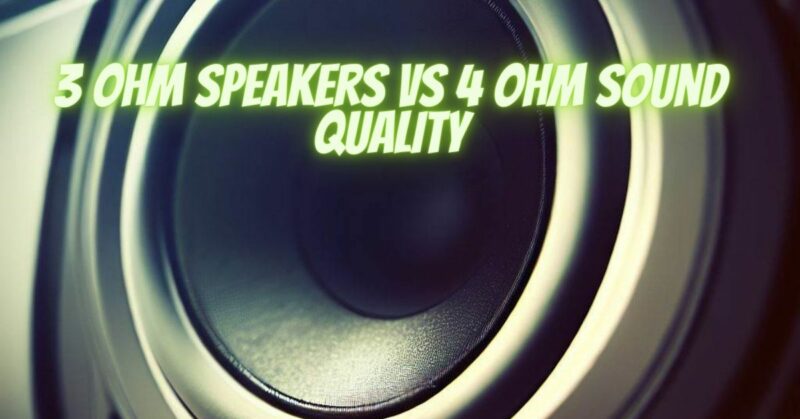When delving into the world of audio equipment, the quest for superior sound quality is paramount. Speaker impedance, measured in ohms (Ω), is a crucial factor that can impact how sound is reproduced. The choice between 3 ohm and 4 ohm speakers can significantly influence sound quality. In this article, we’ll explore the implications of impedance on sound quality and compare the characteristics of 3 ohm and 4 ohm speakers.
Understanding Impedance and Sound Quality
Speaker impedance affects how a speaker interacts with the amplifier and subsequently reproduces sound. The choice of impedance influences various aspects of sound quality, including frequency response, efficiency, and distortion levels.
3 Ohm Speakers: Sound Quality Considerations
Advantages:
- Enhanced Power Transfer: 3 ohm speakers generally allow for more efficient power transfer from the amplifier. This can result in potentially louder sound output and more impactful audio, particularly in larger spaces.
- Bass Response: Lower impedance can contribute to improved control over the movement of the speaker’s cone, especially in the lower frequency range. This can lead to tighter and more pronounced bass response.
- Efficiency: Due to the efficient power transfer, 3 ohm speakers may require less power from the amplifier to achieve a desired sound level. This efficiency can result in less strain on the amplifier and potentially cleaner sound reproduction.
Considerations:
- Amplifier Compatibility: While 3 ohm speakers offer advantages in power transfer and efficiency, it’s crucial to ensure that your amplifier is capable of handling the lower impedance load. Incompatible amplifiers can lead to distortion and potential damage.
- Heat Generation: The increased power transfer of 3 ohm speakers can generate more heat in both the amplifier and the speaker. Adequate cooling becomes more important to maintain sound quality and prevent overheating.
4 Ohm Speakers: Sound Quality Considerations
Advantages:
- Amplifier Stability: 4 ohm speakers generally draw less current from amplifiers, which can lead to improved amplifier stability and reduced risk of distortion, particularly in demanding passages.
- Wider Selection: 4 ohm speakers are a traditional standard, resulting in a broader selection available across various price ranges and quality levels.
Considerations:
- Power Transfer: 4 ohm speakers might offer slightly lower power transfer compared to 3 ohm speakers. This can impact sound output levels, particularly in larger spaces.
- Bass Response: While 4 ohm speakers are still capable of delivering excellent sound quality, they might exhibit slightly different bass response characteristics compared to lower impedance speakers.
Choosing Between 3 Ohm and 4 Ohm Speakers for Sound Quality
Choosing between 3 ohm and 4 ohm speakers in terms of sound quality depends on your audio preferences, equipment compatibility, and intended usage:
- Room Acoustics: Consider the size of the room and its acoustic properties. 3 ohm speakers might excel in larger spaces where increased power transfer is advantageous.
- Amplifier Compatibility: Ensure your amplifier can handle the chosen impedance load. Using an amplifier designed for the chosen impedance is crucial for optimal sound quality.
- Bass and Sound Characteristics: Assess your preference for bass impact and overall sound quality. 3 ohm speakers might provide tighter bass response, while 4 ohm speakers might offer different tonal qualities.
The choice between 3 ohm and 4 ohm speakers impacts sound quality through considerations of power transfer, amplifier compatibility, and personal audio preferences. 3 ohm speakers offer the potential for enhanced power transfer and more impactful bass response, while 4 ohm speakers may provide amplifier stability and a wider selection. By understanding the implications of impedance and evaluating your listening environment, amplifier specifications, and desired sound characteristics, you can select the impedance that aligns with your audio aspirations, ultimately leading to a rewarding and immersive sound experience.

